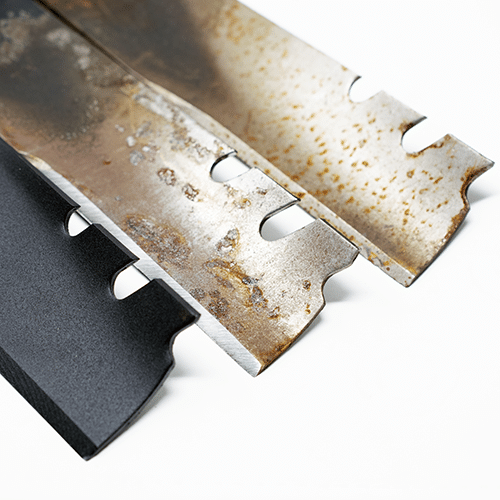A Complete Guide to Lawnmower Blades
Sunlight, rain and nutrient rich soil may not overcome the damage of a dull blade. The health of your lawn depends on a clean cut. Always start the season with sharp blade edges and a clean deck. A sharp lawnmower blade produces a clean cut through grass plants reducing stress and water loss. After the initial cut through the grass plant a sharp blade and quality lawn mower deck reduces the clippings into fine mulch. Small clippings return to the soil surface and feed your lawn. The tips recover quicker from the efficient cut and the fine mulch powers nutrients to the root system.
Renewing and sharpening blades is essential to lawn health. This article helps define a dull blade and explores the benefits of replacing with new and best practices when sharpening blades.
A dull blade
A dull blade leaves grass plants ripped or torn. When grass is torn or loses excessive water, the tips will turn yellow or white. A lawn full of dry, yellow grass is a clear indication that your lawnmower blade is damaging your lawn. A poor blade edge also leaves clumps of grass across your lawn. These clumps block the grass plants from vital sunlight and air. Excess grass clippings may also produce thatch between the soil and air. This effectively chokes your lawn.
Start the season with a sharp or new blade. Keep track of the hours or number of mows you perform. Typically, blades dull after 8-12 hours of use. Visual inspection is not ideal but any nicks and imperfections along the cutting edge demonstrate a dull blade.
Uneven wear, damage and debris will cause a blade to become unbalanced. Unbalanced blades may damage spindles, pulleys and belts. These components are typically far more expensive and more difficult to repair than simply sharpening or replacing dull blades. On newer electric mowers, damaged or unbalanced blades can quickly damage drive motors.
A brand new blade

Genuine factory blades (or Original Equipment Manufacturer) feature the optimal cutting edge both for quality of cut, efficiency and longevity. Lawnmower blades are designed to make a clean cut while remaining effective over a long period of time. For this reason, new blades are never razor sharp or even as sharp as a knife edge. The cutting surface is durable across multiple hours and withstands unseen hazards like small twigs, leaves and in some cases litter. Generally, a new blade may remain productive for 8-12 hours of use. For some homeowners this may be a complete mowing season while others will need to sharpen throughout the season.
Always replace blades with the authentic blades recommended and/or manufactured by the brand. Honda, Hustler, Spartan, Toro and all other brands feature proprietary blades. Using a “universal” blade will alter performance and may even damage your lawnmower.
Finding authentic blades is simple by searching our site using your model number. SHOP OUR BLADE KITS and find all the parts for your model with our Custom Search Tool (HOW TO USE SEARCH TOOL)
A Sharpened Blade

How a blade is sharpened is key to performance and safety. Our staff carefully sharpens and balances blades. These freshly sharpened blades will perform as well or better than a new blade. The cutting edge is so sharp that we coat blades in wax to protect our staff and homeowners when handling sharpened blades. This razor edge cuts through your lawn extremely well and our balancing techniques protect lawnmowers.
There are key differences between new and sharpened blades:
- Sharpened blades dull quickly. The razor edge wears quicker than factory blades.
- Sharpening a blade exposes the metal to oxidation.
- Blades should be carefully balanced during sharpening to prevent damage to lawnmower engines, spindles, pulleys and belts.
- Some blades should not be sharpened because of excessive wear or damage. Any nicks, chips, warping or rounded edges should be considered before sharpening a blade. These imperfections will make balancing the blade more difficult (as examples below demonstrate).



The first image is a blade with excessive chips and nicks. This blade has not been sharpened frequently and should be replaced.
The middle blade is bent. Striking anything in your yard often results in bent blades. Any alteration in the blade may damaged your engine or deck spindles.
The far image shows excessive wear. Eventually a blade must be replaced even if the blade is sharpened regularly.
Our Best Advice
I follow the rule of warm season holidays. I sharpen or install a new blade at the start of the season. I sharpen around Memorial Day, Fourth of July and Labor Day. You can also keep track of how long it takes to mow your lawn and create your own schedule based on sharpening every 8-12 hours of use.
Most walk power mower manufacturers recommend replacing blade annually. Riding mower recommendations vary. Many blades are thicker and may be sharpened numerous times before replacement is required.
You can drop off blades for sharpening any time. Our blade sharpening service takes only a day or two so your mowing schedule won’t be interrupted.
Removing your blade is pretty simple as in the examples below. Refer to owners manual for guidance on turning walk mowers onto their side (always disable the spark plug from the ignition coil and be aware that air intake must be facing upward when servicing your mower). Blades typically are secured with a single bolt and washer (Honda uses 2 bolts and washers).
Editor’s Note: This article was updated on June 16, 2022




Recent Comments